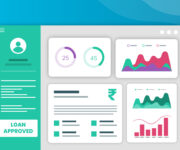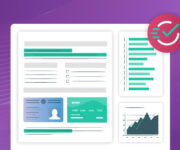The growth of Non-Performing Assets (NPAs) continues to be a top concern for digital lenders, today.
According to reports, Indian banks continue to face challenges in recovering debt. India’s 39 Debt Recovery Tribunals (DRTs) and five Debt Recovery Appellate Tribunals (DRATs) struggle to cope with the volume of cases.
Though 60,000 new cases are reported to be filed yearly, approximately, only 30,000 to 40,000 cases are resolved.
The growth of NPAs eats into cash flows, revenues, and profitability. Hence, in the current scenario lenders must consider becoming self-reliant in their risk assessment and debt recovery strategies.
For instance, the adoption of a lending software solution can help businesses achieve these goals. In this blog post, let’s understand the role of technology in addressing this key challenge.
What is a Lending Software Solution?
A lending software solution that automates the entire lending lifetime cycle. This solution leverages a mix of technologies such as cloud computing, Artificial (AI), Machine Learning (ML), Optical Character Recognition (OCR), and automation to make lending operations efficient and data-driven.
In July 2024, the Reserve Bank of India (RBI) issued fresh guidelines to banks with regard to NPAs. They would need to investigate NPAs and identify willful defaulters with outstanding loan amounts that exceed 25 lakhs.
The adoption of automated lending solutions is an important step towards mitigating credit risk, serving customers more effectively, and driving revenues and profitability. The software’s capabilities help lenders slow down the growth of NPAs and automate a robust debt recovery strategy.
Top NPA Management Strategies with Lending Software Solution
By harnessing the power of lending software solutions, lending businesses can discover strategies to recover from NPAs:
Superior Risk Assessment
Underwriting is one of the most important processes, which enables lenders to make the right decisions. With the amount of financial data on the rise, manual underwriting processes are proving to be ineffective especially as lenders scale. The use of a lending software solution helps automate the entire financial analysis process.
Every bank transaction is categorised into specific inflow or outflow categories. For instance, transactions can be segregated into up to 60 categories. These include salaries, revenue, late EMI payment fees, non-payment penalties, non-compliance penalties, interest earned, capital gains, and business expenses, to name a few.
Category-wise transaction analysis helps lenders assess cash flow accuracy and execute data-driven lending decisions.
Identifying Unusual Transaction Patterns
AI-powered lending software solutions can recognise unusual transaction patterns in bank/ account statements. These patterns are often invisible to the human eye. However, AI can identify and flag them quickly and efficiently. Access to search tools enables lenders to look at financial statements in depth.
Lenders can identify potential fraud cases, fake documents, and doctored account statements. These capabilities strengthen a lender’s ability to detect irregularities and avoid potentially lending to NPAs.
Customised Solutions
As lenders gear up to serve the Micro Small And Medium Enterprises (MSME) sector they must be prepared to personalise products to serve the true needs of borrowers.
This approach enables them to make products that are affordable, and aligned to a borrower’s cash flows. In turn, borrowers will be in a position to pay off loans faster.
Sharing Clear Communication
Borrowers often do not read the terms of their lending agreements. Hence they make errors and delays during the debt payment. They may be unsure of the payment state, the Equated Monthly Installment (EMI) ticket size, the loan repayment tenure, and interest rates.
Simplifying and personalising communication through various channels of preference can help borrowers understand the terms and conditions. They can plan their cash flows, accordingly, and make payments on time.
Enabling Secure Inclusive Payments
Today, consumers make payments via a wide range of payment modes. These include net banking, UPI payments, credit cards, and debit cards, to name a few.
Adoption of a lending software solution not only enables all payment modes. It also provides a secure and seamless payment user journey. Borrowers receive communication about the status of their payments, thus instilling trust in the lender.
Boost Debt Monitoring Mechanisms
Lenders must be proactive in monetary EMI payments, at scale. This approach helps them recognise potential delinquencies early on. A lending software solution has the capability to monitor all payments 24/7.
Also, the system automatically alerts lenders of any missed payments, and lenders can take action instantly.
Adopt Data-driven Debt Recovery Strategies
Outsourcing the debt recovery process to DRTs or recovery agents may not drive recovery results in line with revenue forecasts. Hence lenders need to design a robust debt recovery strategy that expedites debt recovery.
For instance, recovery cases need to be assigned to debt recovery agents with relevant expertise as per the profile of the borrower.
Agents must have access to updated case information so they can liaise with borrowers and respond efficiently. Borrower data such as address, contact, and employment information must be updated in the system regularly. The use of a lending software solution automates these processes. This approach brings transparency and efficiency to the entire debt recovery process life cycle.
Build Customer-centric Processes
One of the most important aspects of debt recovery is to design and execute customer-centric processes. Outsourcing this important function to an external agency can result in alienating borrowers.
A majority of borrowers may experience temporary cash flow problems. This scenario may be caused due to a sudden job loss, or loss of business revenues due to a market downturn.
Those borrowers who endure a poor debt experience then not to be repeat customers. Instead, lenders must be customer-centric in their approach at every step of the way.
By doing so, they can recover debt faster. They can retain customers, cut down on customer acquisition costs, and drive revenues.
The Takeaway
Early investments in a cloud-based lending software solution, can help lenders become strategic and data-driven in their debt recovery processes. As a result, they can curb the growth of NPAs.
Simultaneously, they can become customer-centric in their methods, drive revenues, and boost profitability.
Lenders making early investments in technology can grow their small business audience, and cultivate a new pipeline of business.
Finezza offers a comprehensive set of tools and solutions to manage your lending portfolio. Our end-to-end lending management solutions are trusted by brands like ftcash, Hiranandani Financial Services, gromor Finance, and UC Inclusive Credit, to name a few.
Finezza’s intuitive bank statement analysis software is geared to analyze bank statements with speed, and accuracy and detect potential fraud.
Book a demo to know more.




Leave a Reply